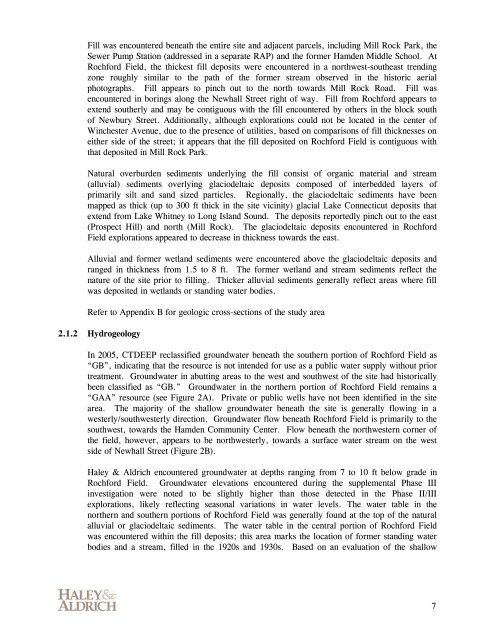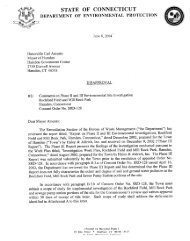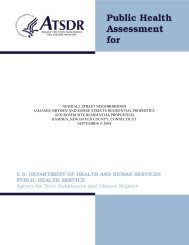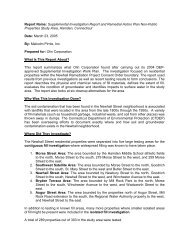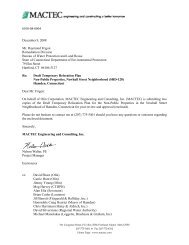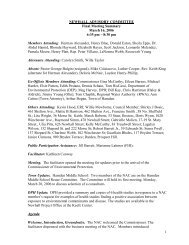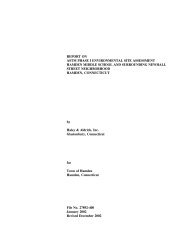Remedial Action Plan - Rochford Field - Newhall Remediation Project
Remedial Action Plan - Rochford Field - Newhall Remediation Project
Remedial Action Plan - Rochford Field - Newhall Remediation Project
Create successful ePaper yourself
Turn your PDF publications into a flip-book with our unique Google optimized e-Paper software.
Fill was encountered beneath the entire site and adjacent parcels, including Mill Rock Park, the<br />
Sewer Pump Station (addressed in a separate RAP) and the former Hamden Middle School. At<br />
<strong>Rochford</strong> <strong>Field</strong>, the thickest fill deposits were encountered in a northwest-southeast trending<br />
zone roughly similar to the path of the former stream observed in the historic aerial<br />
photographs. Fill appears to pinch out to the north towards Mill Rock Road. Fill was<br />
encountered in borings along the <strong>Newhall</strong> Street right of way. Fill from <strong>Rochford</strong> appears to<br />
extend southerly and may be contiguous with the fill encountered by others in the block south<br />
of Newbury Street. Additionally, although explorations could not be located in the center of<br />
Winchester Avenue, due to the presence of utilities, based on comparisons of fill thicknesses on<br />
either side of the street; it appears that the fill deposited on <strong>Rochford</strong> <strong>Field</strong> is contiguous with<br />
that deposited in Mill Rock Park.<br />
Natural overburden sediments underlying the fill consist of organic material and stream<br />
(alluvial) sediments overlying glaciodeltaic deposits composed of interbedded layers of<br />
primarily silt and sand sized particles. Regionally, the glaciodeltaic sediments have been<br />
mapped as thick (up to 300 ft thick in the site vicinity) glacial Lake Connecticut deposits that<br />
extend from Lake Whitney to Long Island Sound. The deposits reportedly pinch out to the east<br />
(Prospect Hill) and north (Mill Rock). The glaciodeltaic deposits encountered in <strong>Rochford</strong><br />
<strong>Field</strong> explorations appeared to decrease in thickness towards the east.<br />
Alluvial and former wetland sediments were encountered above the glaciodeltaic deposits and<br />
ranged in thickness from 1.5 to 8 ft. The former wetland and stream sediments reflect the<br />
nature of the site prior to filling. Thicker alluvial sediments generally reflect areas where fill<br />
was deposited in wetlands or standing water bodies.<br />
Refer to Appendix B for geologic cross-sections of the study area<br />
2.1.2 Hydrogeology<br />
In 2005, CTDEEP reclassified groundwater beneath the southern portion of <strong>Rochford</strong> <strong>Field</strong> as<br />
“GB”, indicating that the resource is not intended for use as a public water supply without prior<br />
treatment. Groundwater in abutting areas to the west and southwest of the site had historically<br />
been classified as “GB.” Groundwater in the northern portion of <strong>Rochford</strong> <strong>Field</strong> remains a<br />
“GAA” resource (see Figure 2A). Private or public wells have not been identified in the site<br />
area. The majority of the shallow groundwater beneath the site is generally flowing in a<br />
westerly/southwesterly direction. Groundwater flow beneath <strong>Rochford</strong> <strong>Field</strong> is primarily to the<br />
southwest, towards the Hamden Community Center. Flow beneath the northwestern corner of<br />
the field, however, appears to be northwesterly, towards a surface water stream on the west<br />
side of <strong>Newhall</strong> Street (Figure 2B).<br />
Haley & Aldrich encountered groundwater at depths ranging from 7 to 10 ft below grade in<br />
<strong>Rochford</strong> <strong>Field</strong>. Groundwater elevations encountered during the supplemental Phase III<br />
investigation were noted to be slightly higher than those detected in the Phase II/III<br />
explorations, likely reflecting seasonal variations in water levels. The water table in the<br />
northern and southern portions of <strong>Rochford</strong> <strong>Field</strong> was generally found at the top of the natural<br />
alluvial or glaciodeltaic sediments. The water table in the central portion of <strong>Rochford</strong> <strong>Field</strong><br />
was encountered within the fill deposits; this area marks the location of former standing water<br />
bodies and a stream, filled in the 1920s and 1930s. Based on an evaluation of the shallow<br />
7


